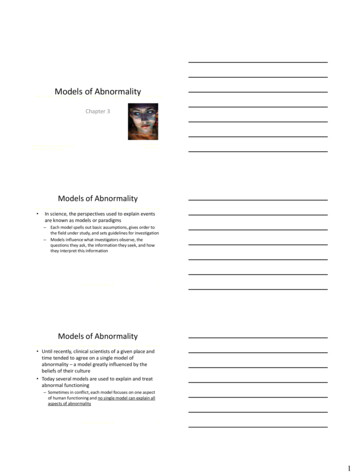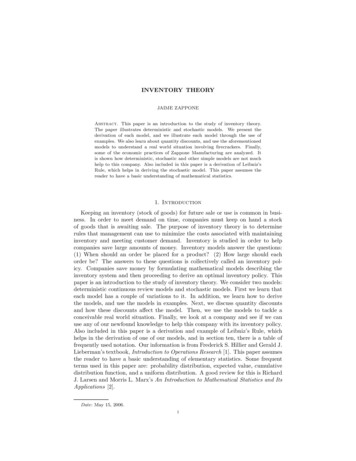
Transcription
Models of AbnormalityChapter 3Comer, AbnormalPsychology, 8eSlides & Handouts by Karen Clay Rhines, Ph.D.Northampton Community CollegeModels of Abnormality In science, the perspectives used to explain eventsare known as models or paradigms– Each model spells out basic assumptions, gives order tothe field under study, and sets guidelines for investigation– Models influence what investigators observe, thequestions they ask, the information they seek, and howthey interpret this informationComer, Abnormal Psychology, 8e2Models of Abnormality Until recently, clinical scientists of a given place andtime tended to agree on a single model ofabnormality – a model greatly influenced by thebeliefs of their culture Today several models are used to explain and treatabnormal functioning– Sometimes in conflict, each model focuses on one aspectof human functioning and no single model can explain allaspects of abnormalityComer, Abnormal Psychology, 8e31
The Biological Model Adopts a medical perspective Main focus is that psychological abnormality isan illness brought about by malfunctioningparts of the organism– Typically point to problems in brain anatomy orbrain chemistryComer, Abnormal Psychology, 8e4How Do Biological Theorists ExplainAbnormal Behavior? Brain anatomy and abnormal behavior– Clinical researchers have discovered connectionsbetween certain psychological disorders andproblems in specific brain areas Example: Huntington’s disease and basal ganglia(forebrain)Comer, Abnormal Psychology, 8e5How Do Biological Theorists ExplainAbnormal Behavior? Brain chemistry and abnormal behavior– Researchers have identified dozens of NTs Examples: serotonin, dopamine, and GABA– Studies indicate that abnormal activity in certainNTs can lead to specific mental disorders For example: depression has been linked to low activityin serotonin and norepinephrineComer, Abnormal Psychology, 8e62
How Do Biological Theorists ExplainAbnormal Behavior? Brain chemistry and abnormal behavior– Additionally, researchers have learned that mentaldisorders are sometimes related to abnormal chemicalactivity in the endocrine system– Endocrine glands release hormones which propel bodyorgans into action Abnormal secretions have been linked to psychological disorders– Example: Cortisol release is related to anxiety and mooddisordersComer, Abnormal Psychology, 8e7Sources of Biological Abnormalities –Genetics Abnormalities in brain anatomy or chemistry aresometimes the result of genetic inheritance– Each cell in the human body contains 23 pairs ofchromosomes, each with numerous genes thatcontrol the characteristics and traits a person inherits– Studies suggest that inheritance plays a part in mooddisorders, schizophrenia, and other mental disorders Appears that in most cases several genes combine toproduce our actions and reactionsComer, Abnormal Psychology, 8e8Sources of Biological Abnormalities –Genetics Genes that contribute to mental disorders areviewed as unfortunate occurrences:– May be mutations– May be inherited after a mutation in the familyline– May be the result of normal evolutionaryprinciplesComer, Abnormal Psychology, 8e93
Sources of Biological Abnormalities –Evolution Evolutionary theorists argue that humanreactions and the genes responsible for themhave survived over the course of time becausethey have helped individuals thrive and adapt– Example: The fear response In today’s world, however, those genes andreactions may not be so adapativeComer, Abnormal Psychology, 8e10Sources of Biological Abnormalities –Viral Infections Another possible source of abnormal brainstructure or biochemical dysfunction is viralinfections– Example: Schizophrenia and prenatal viral exposure Interest in viral explanations of psychologicaldisorders has been growing in the past decade– Example: Anxiety and mood disordersComer, Abnormal Psychology, 8e11Biological Treatments Biological practitioners attempt to pinpointthe physical source of dysfunction todetermine the course of treatment Three types of biological treatment:– Drug therapy– Electroconvulsive therapy (ECT)– PsychosurgeryComer, Abnormal Psychology, 8e124
Biological Treatments Drug therapy:– 1950s advent of psychotropic medications Greatly changed the outlook for a number of mental disorders– Four major drug groups: Antianxiety drugs (anxiolytics; minor tranquilizers)Antidepressant drugsAntibipolar drugs (mood stabilizers)Antipsychotic drugsComer, Abnormal Psychology, 8e13Biological Treatments Electroconvulsive therapy (ECT):– Used primarily for depression, particularly whendrugs and other therapies have failed This treatment is used on tens of thousands ofdepressed persons annuallyComer, Abnormal Psychology, 8e14Biological Treatments Psychosurgery (or neurosurgery):– Historical roots in trephination– 1930s first lobotomy– Much more precise today than in the past– Considered experimental and used only inextreme casesComer, Abnormal Psychology, 8e155
Assessing theBiological Model Strengths: Weaknesses:– Enjoys considerablerespect in the field– Constantly producesvaluable newinformation– Treatments bring greatrelief– Can limit, rather thanenhance, our understanding Too simplistic– Treatments producesignificant undesirable(negative) effectsComer, Abnormal Psychology, 8e16The Psychodynamic Model Oldest and most famous psychological model Based on belief that a person’s behavior (whether normal orabnormal) is determined largely by underlying dynamic - thatis, interacting - psychological forces of which she or he is notconsciously aware– Abnormal symptoms are the result of conflict among these forces Father of psychodynamic theory and psychoanalytic therapy:– Sigmund Freud (1856–1939)Comer, Abnormal Psychology, 8e17How Did Freud ExplainNormal and Abnormal Functioning? Shaped by three UNCONSCIOUS forces:1. Id – guided by the Pleasure Principle Instinctual needs, drives, and impulses Sexual; fueled by libido (sexual energy)2. Ego – guided by the Reality Principle Seeks gratification, but guides us to know when we can andcannot express our wishes Ego defense mechanisms protect us from anxietyComer, Abnormal Psychology, 8e186
Comer, Abnormal Psychology, 8e19How Did Freud ExplainNormal and Abnormal Functioning? Caused by three UNCONSCIOUS forces:3. Superego – guided by the Morality Principle Conscience; unconsciously adopted from our parents These three parts of the personality are often insome degree of conflict– A healthy personality is one in which an effective workingrelationship exists among the three forces– If the id, ego, and superego are in excessive conflict, theperson’s behavior may show signs of dysfunctionComer, Abnormal Psychology, 8e20How Did Freud ExplainNormal and Abnormal Functioning? Developmental stages– Freud proposed that at each stage of development newevents and pressures require adjustment in the id, ego,and superego If successful personal growth If unsuccessful fixation at an early developmental stage, leadingto psychological abnormality– Because parents are the key figures in early life, they are often seenas the cause of improper developmentComer, Abnormal Psychology, 8e217
How Did Freud ExplainNormal and Abnormal Functioning? Developmental stages– Oral (0 to 18 months of age)– Anal (18 months to 3 years of age)– Phallic (3 to 5 years of age)– Latency (5 to 12 years of age)– Genital (12 years of age to adulthood)Comer, Abnormal Psychology, 8e22How Do Other Psychodynamic ExplanationsDiffer from Freud’s? Although new theories depart from Freud’s ideas inimportant ways, each retains the belief that humanfunctioning is shaped by dynamic (interacting) forces:– Ego theorists Emphasize the role of the ego; consider it independent andpowerful– Self theorists Emphasize the unified personality– Object-relations theorists Emphasize the human need for relationships, especially betweenchildren and caregiversComer, Abnormal Psychology, 8e23Psychodynamic Therapies All seek to uncover past trauma and innerconflicts and therapist acts as a “subtle guide” Utilize various techniques:– Free association– Therapist interpretation– Catharsis– Working throughComer, Abnormal Psychology, 8e248
Assessing thePsychodynamic Model Strengths: Weaknesses:– First to recognize importanceof psychological theories andtreatment– Saw abnormal functioning asrooted in the same processesas normal functioning– First to apply theory andtechniques systematically totreatment – monumentalimpact on the field– Unsupported ideas;difficult to research Non-observable Inaccessible to humansubject (unconscious)Comer, Abnormal Psychology, 8e25The Behavioral Model Like psychodynamic theorists, behavioraltheorists believe that our actions aredetermined largely by our experiences in life Concentrates wholly on behaviors andenvironmental factors Bases explanations and treatments onprinciples of learningComer, Abnormal Psychology, 8e26The Behavioral Model The model began in laboratories whereconditioning studies were conducted– Several forms of conditioning: Operant conditioning Modeling – Bobo the Clown– http://youtu.be/8ZXOp5PopIA?t 2s Classical conditioning - Pavloc– All may produce normal or abnormal behaviorComer, Abnormal Psychology, 8e279
Behavioral Therapies Aim to identify the behaviors that are causingproblems and replace them with moreappropriate ones– May use classical conditioning, operantconditioning, or modeling Therapist is “teacher” rather than healerComer, Abnormal Psychology, 8e28Behavioral Therapies Classical conditioning treatments may be usedto change abnormal reactions to particularstimuli– Example: systematic desensitization for phobia Step-by-step procedure– Learn relaxation skills– Construct a fear hierarchy– Confront feared situationsComer, Abnormal Psychology, 8e29Assessing the Behavioral Model Strengths: Weaknesses:– Powerful force in thefield– Can be tested in thelaboratory– Significant researchsupport for behavioraltherapies– No evidence thatsymptoms are ordinarilyacquired throughconditioning– Behavior therapy islimited– Too simplistic New focus onself-efficacy, socialcognition, and cognitivebehavioral theoriesComer, Abnormal Psychology, 8e3010
The Cognitive Model This model proposes that we can best understandabnormal functioning by looking at cognitiveprocesses – the center of behaviors, thoughts, andemotions Argues that clinicians must ask questions aboutassumptions, attitudes, and thoughts of a clientComer, Abnormal Psychology, 8e31How Do Cognitive Theorists Explain AbnormalFunctioning? Abnormal functioning can result from severalkinds of cognitive problems:– Faulty assumptions and attitudes– Illogical thinking processes– Example: overgeneralizationComer, Abnormal Psychology, 8e32Cognitive Therapies People can overcome their problems by developingnew ways of thinking Main model: Beck’s Cognitive Therapy– The goal of therapy is to help clients recognize andrestructure their thinking Therapists also guide clients to challenge their dysfunctionalthoughts, try out new interpretations, and apply new ways ofthinking in their daily lives Widely used in treating depressionComer, Abnormal Psychology, 8e3311
Assessing theCognitive Model Strengths: Weaknesses:– Very broad appeal– Clinically useful and effective– Focuses on a uniquely humanprocess– Theories lend themselves toresearch– Therapies effective in treatingseveral disorders– Precise role of cognition inabnormality has yet to bedetermined– Therapies do not helpeveryone– Some changes may not bepossible to achieve In response, a new wave oftherapies has emerged,including Acceptance andCommitment Therapy andmindfulness-based techniquesComer, Abnormal Psychology, 8e34The Humanistic-Existential Model Combination model– The humanist view Emphasis on people as friendly, cooperative, andconstructive; focus on drive to self-actualize throughhonest recognition of strengths and weaknesses– The existentialist view Emphasis on self-determination, choice, and individualresponsibility; focus on authenticityComer, Abnormal Psychology, 8e35Rogers’ HumanisticTheory and Therapy Believes in the basic human need for unconditional positive regard– If received, leads to unconditional self-regard– If not, leads to “conditions of worth” Incapable of self-actualization because of distortion – do not know whatthey really need, etc. Rogers’ “client-centered” therapy– Therapist creates a supportive climate Unconditional positive regard Accurate empathy Genuineness– Little research support but positive impact on clinical practiceComer, Abnormal Psychology, 8e3612
Gestalt Theory and Therapy Humanistic approach– Developed by Fritz Perls– Goal is to guide clients toward self-recognitionthrough challenge and frustration– Techniques: Skillful frustration Role playing Rules, including “Here and Now” and “I” language– Little research supportComer, Abnormal Psychology, 8e37Spiritual Views and Interventions For most of the twentieth century, clinicalscientists viewed religion as a negative—or atbest neutral—factor in mental health This historical alienation between the clinicalfield and religion seems to be ending Researchers have learned that spirituality can,in fact, be of psychological benefit to peopleComer, Abnormal Psychology, 8e38Existential Theories and Therapy Belief that psychological dysfunction is causedby self-deception; people hide from life’sresponsibilities and fail to recognize that it isup to them to give meaning to their lives In therapy, people are encouraged to acceptpersonal responsibility for their problems– Goals more important than technique– Great emphasis placed on client-therapistrelationshipComer, Abnormal Psychology, 8e3913
Existential Theories and Therapy Existential therapists do not believe thatexperimental methods can adequately test theeffectiveness of their treatments; as a result,little controlled research has been conducted40Comer, Abnormal Psychology, 8eAssessing the Humanistic-ExistentialModel Strengths: Weaknesses:– Taps into domainsmissing from othertheories– Emphasizes theindividual– Optimistic– Emphasizes health– Focuses on abstractissues Difficult to research– Weakened bydisapproval of scientificapproach Changing somewhatComer, Abnormal Psychology, 8e41The Sociocultural Models Argue that abnormal behavior is bestunderstood in light of the social and culturalforces that influence an individual– Address norms and roles in society Comprised of two major perspectives:– Family-Social perspective– Multicultural perspectiveComer, Abnormal Psychology, 8e4214
How Do Family-Social Theorists ExplainAbnormal Functioning? Proponents of this model argue that theoristsshould concentrate on forces that operatedirectly on an individual, including:– Social labels and roles Diagnostic labels (example: Rosenhan study)– Social connections and supportsComer, Abnormal Psychology, 8e43How Do Family-Social Theorists ExplainAbnormal Functioning? Focus on:– Family structure and communication Family systems theory argues that abnormalfunctioning within a family leads to abnormal behavior(insane behavior becomes sane in an insaneenvironment)– Examples: enmeshed, disengaged structuresComer, Abnormal Psychology, 8e44Family-Social Treatments This perspective has helped spur the growthof several treatment approaches, including:– Group therapy– Family therapy– Couple therapy– Community treatment Includes prevention workComer, Abnormal Psychology, 8e4515
How Do Multicultural Theorists ExplainAbnormal Functioning? Culture refers to the set of values, attitudes, beliefs,history, and behaviors shared by a group of peopleand communicated from one generation to the next– The multicultural, or culturally diverse, perspective hasemerged as a growing field of study– Multicultural psychologists seek to understand howculture, race, ethnicity, gender, and similar factors affectbehavior and thought, as well as how people of differentcultures, races, and genders differ psychologicallyComer, Abnormal Psychology, 8e46How Do Multicultural Theorists ExplainAbnormal Functioning? The model holds that an individual’s behavior is bestunderstood when examined in the light of thatindividual’s unique cultural context They also have noticed that the prejudice anddiscrimination faced by many minority groups maycontribute to certain forms of abnormal functioningComer, Abnormal Psychology, 8e47Multicultural Treatments Studies have found that members of ethnicand racial minority groups tend to show lessimprovement in clinical treatment thanmembers of majority groups– Two features of treatment can increase atherapist’s effectiveness with minority clients: Greater sensitivity to cultural issues Inclusion of cultural models in treatment, especially intherapies for children and adolescentsComer, Abnormal Psychology, 8e4816
Multicultural Treatments Given such findings, some clinicians havedeveloped culture-sensitive therapies as wellas gender-sensitive, or feminist, therapies49Comer, Abnormal Psychology, 8eAssessing theSociocultural Models Strengths: Weaknesses:– Added greatly to theclinical understanding andtreatment of abnormality Increased awareness ofclinical and social roles– Clinically successful whenother treatments havefailed– Research is difficult tointerpret Correlation causation– Model unable to predictabnormality in specificindividualsComer, Abnormal Psychology, 8e50Integration of the Models Today’s leading models vary widely and noneof the models has proved consistentlysuperiorComer, Abnormal Psychology, 8e5117
Comparing the ModelsComer, Abnormal Psychology, 8e52Integration of the Models A growing number of clinicians favorexplanations of abnormal behavior thatconsider more than one cause at a time– These are sometimes called biopsychosocialtheories Abnormality results from the interaction of genetic,biological, developmental, emotional, behavioral,cognitive, social, and societal influencesComer, Abnormal Psychology, 8e53Integration of the Models Integrative therapists are often called“eclectic” – taking the strengths from eachmodel and using them in combination– See Figure 3-5 on page 61Comer, Abnormal Psychology, 8e5418
Comer, Abnormal Psychology, 8e 8 Sources of Biological Abnormalities – Genetics Genes that contribute to mental disorders are viewed as unfortunate occurrences: –May be mutations –May be inherited after a mutation in the family line –May be the result of normal evolutionary principles C










